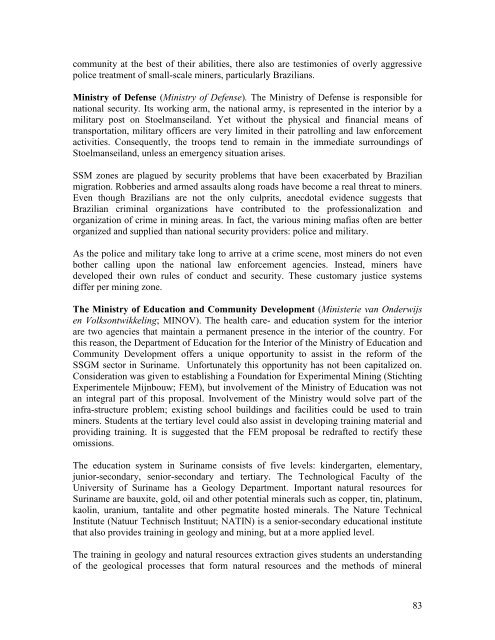SITUATION ANALYSIS OF THE SMALL-SCALE GOLD ... - WWF
SITUATION ANALYSIS OF THE SMALL-SCALE GOLD ... - WWF
SITUATION ANALYSIS OF THE SMALL-SCALE GOLD ... - WWF
You also want an ePaper? Increase the reach of your titles
YUMPU automatically turns print PDFs into web optimized ePapers that Google loves.
community at the best of their abilities, there also are testimonies of overly aggressive<br />
police treatment of small-scale miners, particularly Brazilians.<br />
Ministry of Defense (Ministry of Defense). The Ministry of Defense is responsible for<br />
national security. Its working arm, the national army, is represented in the interior by a<br />
military post on Stoelmanseiland. Yet without the physical and financial means of<br />
transportation, military officers are very limited in their patrolling and law enforcement<br />
activities. Consequently, the troops tend to remain in the immediate surroundings of<br />
Stoelmanseiland, unless an emergency situation arises.<br />
SSM zones are plagued by security problems that have been exacerbated by Brazilian<br />
migration. Robberies and armed assaults along roads have become a real threat to miners.<br />
Even though Brazilians are not the only culprits, anecdotal evidence suggests that<br />
Brazilian criminal organizations have contributed to the professionalization and<br />
organization of crime in mining areas. In fact, the various mining mafias often are better<br />
organized and supplied than national security providers: police and military.<br />
As the police and military take long to arrive at a crime scene, most miners do not even<br />
bother calling upon the national law enforcement agencies. Instead, miners have<br />
developed their own rules of conduct and security. These customary justice systems<br />
differ per mining zone.<br />
The Ministry of Education and Community Development (Ministerie van Onderwijs<br />
en Volksontwikkeling; MINOV). The health care- and education system for the interior<br />
are two agencies that maintain a permanent presence in the interior of the country. For<br />
this reason, the Department of Education for the Interior of the Ministry of Education and<br />
Community Development offers a unique opportunity to assist in the reform of the<br />
SSGM sector in Suriname. Unfortunately this opportunity has not been capitalized on.<br />
Consideration was given to establishing a Foundation for Experimental Mining (Stichting<br />
Experimentele Mijnbouw; FEM), but involvement of the Ministry of Education was not<br />
an integral part of this proposal. Involvement of the Ministry would solve part of the<br />
infra-structure problem; existing school buildings and facilities could be used to train<br />
miners. Students at the tertiary level could also assist in developing training material and<br />
providing training. It is suggested that the FEM proposal be redrafted to rectify these<br />
omissions.<br />
The education system in Suriname consists of five levels: kindergarten, elementary,<br />
junior-secondary, senior-secondary and tertiary. The Technological Faculty of the<br />
University of Suriname has a Geology Department. Important natural resources for<br />
Suriname are bauxite, gold, oil and other potential minerals such as copper, tin, platinum,<br />
kaolin, uranium, tantalite and other pegmatite hosted minerals. The Nature Technical<br />
Institute (Natuur Technisch Instituut; NATIN) is a senior-secondary educational institute<br />
that also provides training in geology and mining, but at a more applied level.<br />
The training in geology and natural resources extraction gives students an understanding<br />
of the geological processes that form natural resources and the methods of mineral<br />
83
















